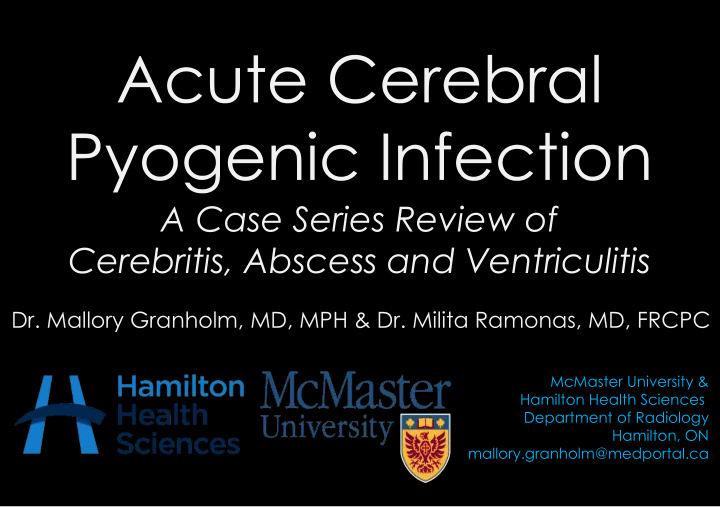



A Case Series Review of Cerebritis, Abscess and Ventriculitis Dr. Mallory Granholm, MD, MPH & Dr. Milita Ramonas, MD, FRCPC McMaster University & Hamilton Health Sciences Department of Radiology Hamilton, ON mallory.granholm@medportal.ca
Declaration of Conflict of Interest We do not have a relationship with a for-profit and / or a not-for profit organization to disclose
Acute Cerebral Pyogenic Infection The Highlights Clinical History is KEY (but can be non-specific) This process follows a (predictable) spectrum Pyogenic Early Late Early Late Cerebritis Abscess Ventriculitis Classic Abscess: ring enhancement, T2 hypo capsule, restricted diffusion Understanding of the spectrum and complications of acute pyogenic infection will aid the Beware of ventriculitis (high mortality) radiologist to make a timely diagnosis in this acute disease that carries high mortality
Case 3 Indication: 54-year-old female, overdose on Eliquis, decreased level of awareness, rule out bleed Additional provided history indicated headache, fever, cough, increased sputum
Case 3 Initial CT Head C-
(late abscess/pyogenic ventriculitis) Case 3 = ruptured abscess + ventriculitis Initial CT Head C- Findings Two hypodense frontal lobe lesions with peripheral rind of hyperdensity ( ↓ ) Varying surrounding vasogenic edema One abuts the ventricle with focal discontinuity ( ↓ ) Irregular ventricular debris layering dependently ( ← )
(late abscess/pyogenic ventriculitis) Case 3 = ruptured abscess + ventriculitis MRI Brain (18h later) T2 FLAIR T1 w/GAD DWI ADC
(late abscess/pyogenic ventriculitis) Case 3 = ruptured abscess + ventriculitis MRI Brain (18h later) T2 FLAIR T1 w/GAD DWI ADC Findings Peripherally enhancing ( ↓ ) centrally restricting lesion (abscess, ↓ ), which communicates with the ventricle (rupture and decompression) with extensive amount of restricting material in the intraventricular system (pus , ← ) Enhancement of ependyma (ventriculitis), hydrocephalus Significant surrounding T2 hyperintensity (vasogenic edema)
(late abscess/pyogenic ventriculitis) Case 3 = ruptured abscesses + ventriculitis MRI Brain (POD #14, shunt fluid + Streptococcus anginosis ) T2 FLAR T1 w/GAD DWI ADC Unfortunately, the patient expired 10 days later
References Brant, W., & Helms, C. (2012). Fundamentals of diagnostic radiology. Wolters Kluwer/Lippincott Williams & Wilkins. Forbes, K., Pipe, J., & Heiserman, J. (2001, 3 1). Evidence for cytotoxic edema in the pathogenesis of cerebral venous infarction. AJNR. American journal of neuroradiology, 22 (3), 450-5. Hong, J., Son, B., Sung, J., Kim, I., Yang, S., Lee, S., & Park, C. (2008, 2). Significance of diffusion-weighted imaging and apparent diffusion coefficient maps for the evaluation of pyogenic ventriculitis. Clinical neurology and neurosurgery, 110 (2), 137-44. Jorens, P., Voormolen, M., Robert, D., & Parizel, P. (2009, 12 18). Imaging Findings in Pyogenic Ventriculitis. Neurocritical Care, 11 (3), 403-405. Kanazawa, M., Wakasugi, N., Hatakeyama, M., Shimohata, T., & Nishizawa, M. (2015, 10 15). Fluid – fluid levels in lateral ventricles predict bacterial CNS infections. Journal of the Neurological Sciences, 357 (1-2), 292-294. Lee, G., Antelo, F., & Mlikotic, A. (2009, 7 1). Cerebral Toxoplasmosis. RadioGraphics, 29 (4), 1200-1205. Raibagkar, P., Neagu, M., Lyons, J., & Klein, J. (2014, 12 28). Imaging in Neurologic Infections I: Bacterial and Parasitic Diseases. Current Infectious Disease Reports, 16 (12), 443. Vachha, B., Moonis, G., & Holodny, A. (2017, 1). Infections of the Brain and Meninges. Seminars in Roentgenology, 52 (1), 2-9.
Recommend
More recommend